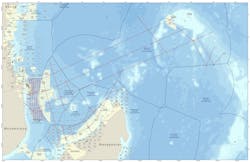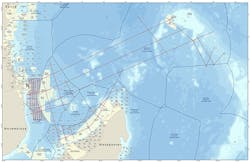EAGE 2019: CGG reassessing prospectivity of western Indian Ocean
Offshore staff
LONDON – CGG plans a new 2D multi-client regional survey over frontier basins offshore East Africa and in the West Indian Ocean.
The company’s geoscientists have been re-evaluating existing data across the region. Legacy geophysical and geological datasets suggest oceanic crust is prevalent throughout the West Indian Ocean, forming the Comoros and Glorioso Islands, Mauritius and a large part of the submarine ridge between Mauritius and the Seychelles.
However, recent investigations also provide strong evidence of slivers of continental crust.
One well-known example of a micro-continent in the region is the Seychelles Bank. Exploration wells drilled in 1981, 120 km (74.6 mi) west of the main islands, confirmed the presence of a working petroleum system with oil shows and a mature Lower-Middle Jurassic source rock.
Robertson Plate Kinematics reconstruction models of the West Indian Ocean reveal the complexity of the poly-phased break-up of Gondwana. There may be many more continental fragments similar to the Seychelles Bank scattered over the region.
Studies on refraction seismic and gravity data in 2013 suggest the continental platform on which the main Seychelles Islands are located may extend further to the west and southwest, and possibly to the south around Mauritius.
Here, gravity survey analysis indicates an anomalously thick crust of 25-30 km (15.5-18.6 mi) compared to the 5-10 km (3.1-6.2 mi) thick surrounding oceanic crust, and a geological study showed that zircons found on Mauritius were of continental origin with varying ages.
To the west, large sandstone xenoliths have been found on the Comoran island of Anjouan and sandstone inclusions in lavas on Grande Comore and Mohéli. In addition, geochemical analysis has matched tar balls on Grande Comore to a Jurassic source rock.
Offshore seismic reflection data acquired west of the Comoros islands and east of the Davie Fracture Zone revealed tilted fault blocks with stratal growth at depth, demonstrating the presence of a rifted continental section.
The various findings indicate that there may be more prospective continental basins off East Africa and in the West Indian Ocean than was previously thought, CGG said.
The planned new 2D survey should deliver the new seismic, gravity and magnetic data needed for an integrated interpretation study.
CGG also announced a new collaboration with Microsoft, under which it will deliver its geoscience products, data and services on Microsoft Azure.
06/06/2019

